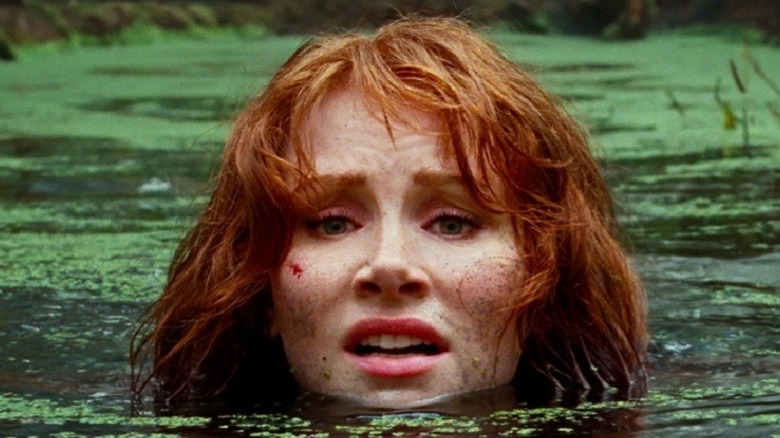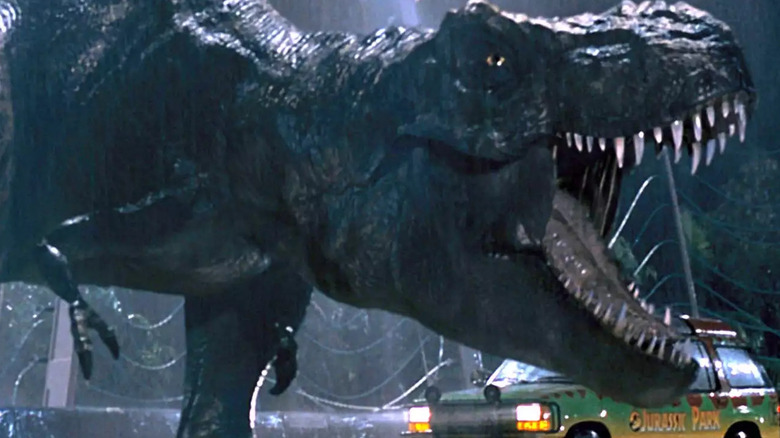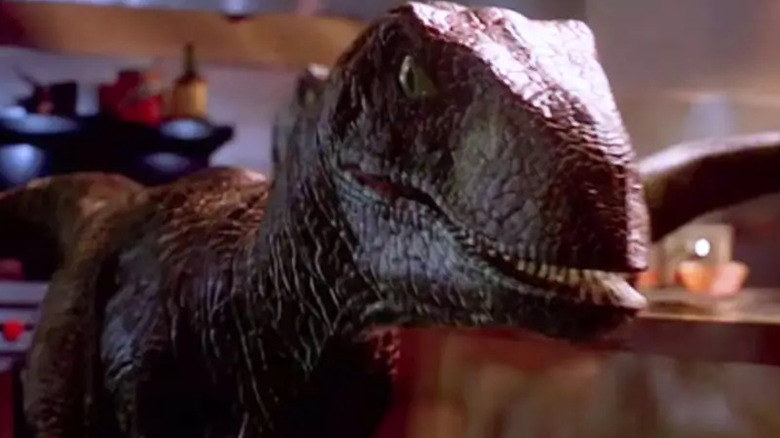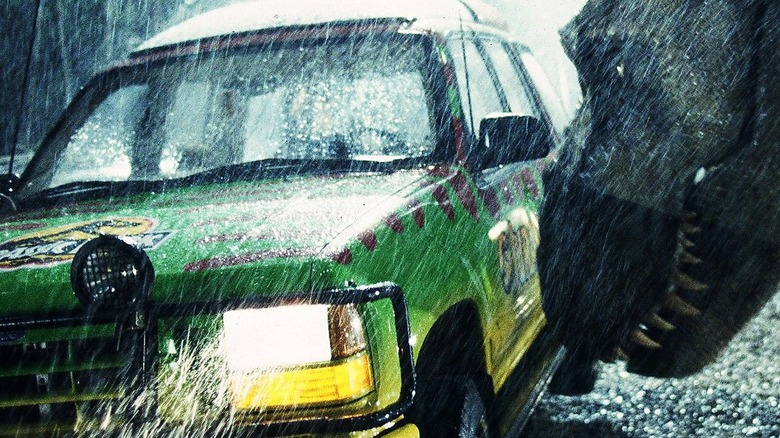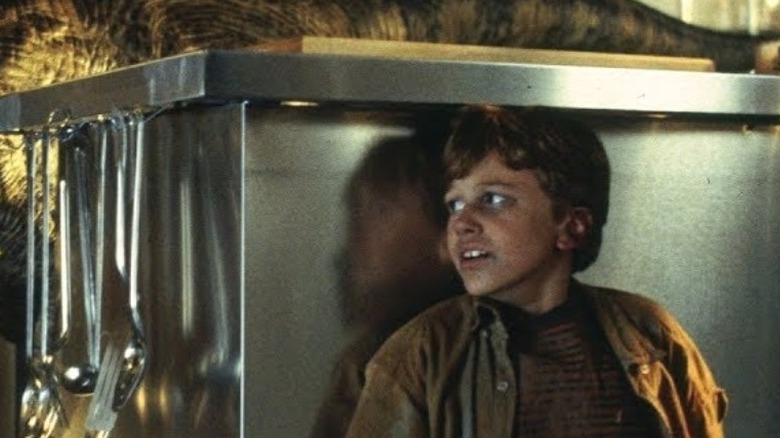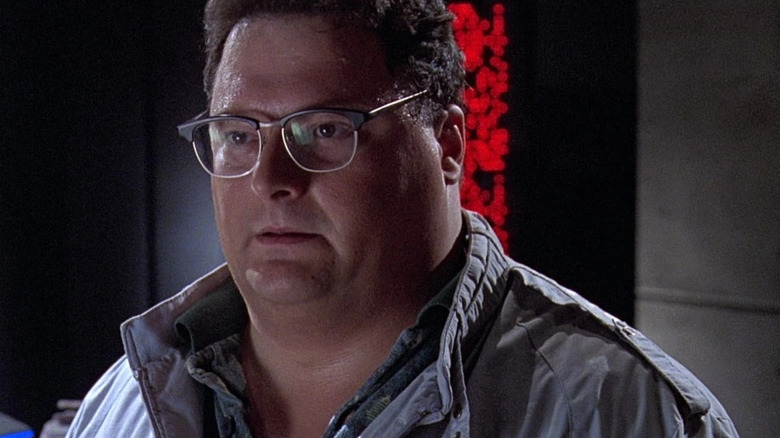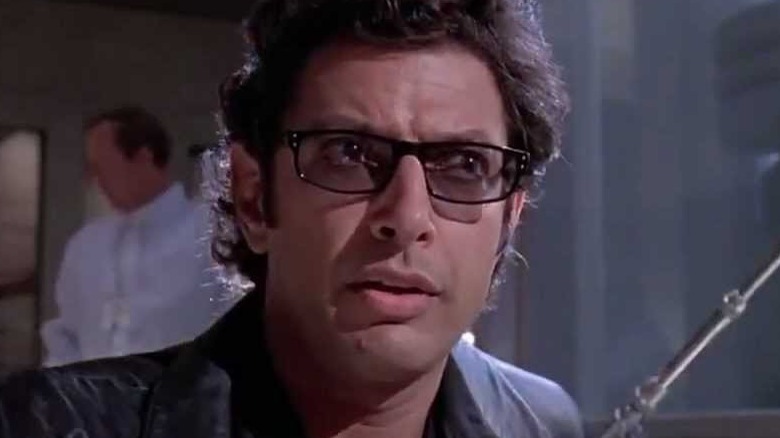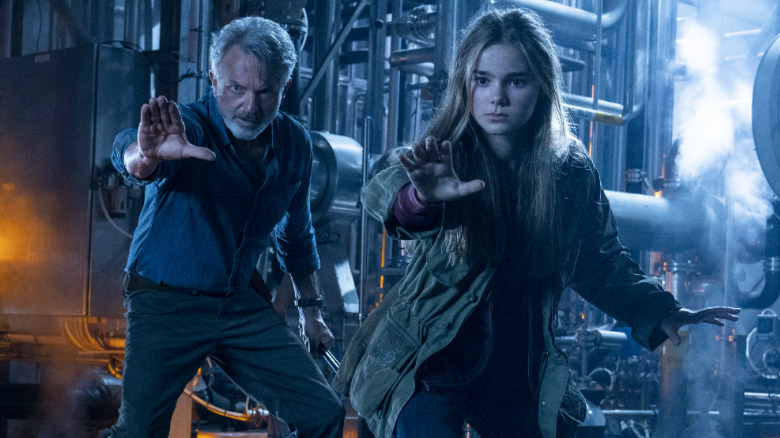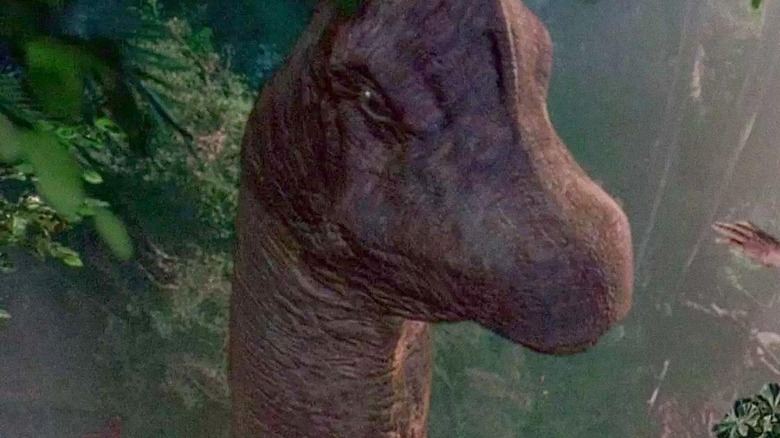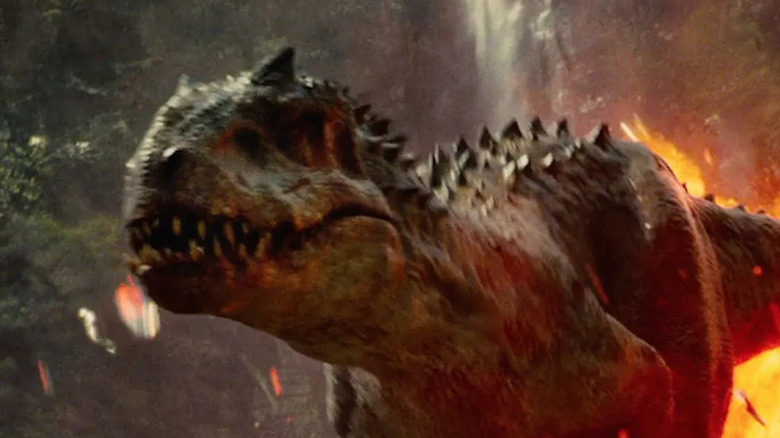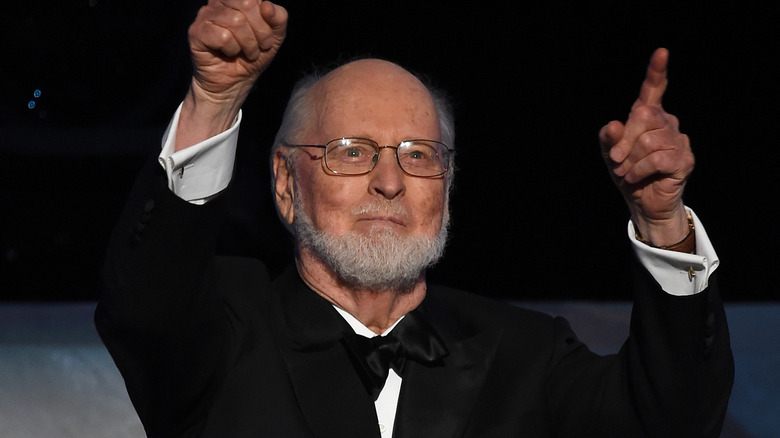Things That Happen In Every Jurassic Park Movie
The 1993 blockbuster sci-fi thriller "Jurassic Park" — directed by Steven Spielberg and based on the popular novel of the same name by Michael Crichton — is a well-loved classic for a reason: it's got dinosaurs. Enough said. Beyond that, though, the film also pioneered GGI (or computer-generated imagery) visual effects in films, which were just in their infancy at the time. While there had been earlier examples of CGI — such as "Tron," "The Abyss," and "Terminator 2: Judgement Day" — none dealt with organic creatures in the same way "Jurassic Park" did. This is what made the film's effects so groundbreaking.
It also revitalized interest in dinosaurs and paleontology and helped popularize theories that weren't as mainstream at the time, such as dinosaurs evolving into birds. Furthermore, it totally re-imagined dinosaurs — such as the Tyrannosaurus rex — running fast while crouched with their tail parallel to the ground, rather than lumbering upright with their tail dragging on the ground, like in most early depictions.
Of course, a litany of sequels were released based on the immediate massive success of "Jurassic Park." Though the newer films could never capture the magic from the first film, they all still have dinosaurs in them, so they're not all bad. More than that, like most long-running franchises, they also often share similar scenes, tropes, characters, etc. that are repeated throughout the series.
So which things have happened across all of the films? Let's take a look. (Warning: This post does contain some spoilers about all of the films, including "Jurassic World Dominion.")
T-Rex chase scene
The T-Rex, whose scientific name "Tyrannosaurus rex" literally translates to "King of the Lizards" in Latin, is arguably the most popular dinosaur ever. Once the first T-Rex fossils were found in the late 1800s and early 1900s, they pretty much captured the imagination of both the public, as well as the scientific community at large. While there have been bigger and subjectively more impressive dinosaurs in the intervening years (with some recent — though, admittedly, unpopular — theories suggesting the T-Rex wasn't even an apex predator, but rather a scavenger), the original T-Rex has kept its popularity among the masses. The people's dinosaur, if you will.
So it makes sense that Michael Crichton, who wrote the original novel, and the aforementioned Steven Spielberg, who directed the film, would want the T-Rex to be a major dinosaur in "Jurassic Park" due to its undeniable icon status. And this has remained true throughout the "Jurassic Park" and the rebooted "Jurassic World" series. In fact, in every single "Jurassic" film, there's an instantly iconic T-Rex chase scene. There's the classic rain-soaked padlock escape scene in the original "Jurassic Park," the mobile lab scene with two T-Rexes in "Jurassic Park: The Lost World," and the chase preceding the infamous T-Rex vs. Spinosaurus scene in "Jurassic Park III."
The "Jurassic World" films are no exception. In fact, the T-Rex chase scene in the first "Jurassic World" caused a lot of discussion about the verisimilitude of outrunning it while in high heels.
Velociraptors being smart
Beyond the famous Tyrannosaurus rex, the second-most popular dinosaur is probably the Velociraptor. It makes sense, too. In contrast with the large, lumbering T-Rex, the Velociraptors are, by contrast, smaller, lighter, and more agile. They're also cool looking. It's even more impressive when you realize that they really only became popular after the movie, and shot up in popularity immediately afterward, while the T-Rex had about a century's head start.
Furthermore, the Velociraptors have been shown to be much smarter than most other dinosaur species in the series. The raptors regularly work in packs, can open doors, and even completely outsmart the supposedly experienced game hunter Robert Muldoon (portrayed by actor Bob Peck) in the first "Jurassic Park." Clever girl, indeed.
They are also one of the few dinosaur species to exist in all six films in the "Jurassic" series. Furthermore, they only grew smarter as the series went on. In "Jurassic Park III," for instance, Dr. Alan Grant (Sam Neill) — the protagonist of the first film — is able to communicate with them by using a modified skull. By the "Jurassic World" films, they've been fully trained by Chris Pratt's Owen Grady, and by "Jurassic World: Dominion," they're taking on seasoned CIA operatives.
Custom vehicles
"Jurassic Park" is an undeniably great film. It's suspenseful, funny, exciting, and has a great cast playing wonderful, iconic characters. And, of course, there're awesome dinosaurs running around, rendered in CGI that still holds up (for the most part) even today! However, with all the money Universal had put into it — especially after an expensive bidding war with other studios to get the film rights to Crichton's novel in the first place — "Jurassic Park" was also made to push merchandise, especially during the extremely toy-happy '90s. In fact, a lot of the film's actual, official merchandise can be seen in the film itself.
This is most clear with the different, custom vehicles in the film. There are even two different SUV designs: the green ones with stripes used on the tour and the red-and-gray ones used when John Hammond (Richard Attenborough) shows Dr. Grant and Ellie Sattler (Laura Dern) the pack of Brachiosauruses for the first time.
The sequels followed suit with increasingly unique (and dare we say, "toyetic") designs. This includes the mobile lab in "The Lost World," the rolling glass Gyrospheres in "Jurassic World," and the sleek and futuristic ByoSin helicopter from the most recent "Jurassic World: Dominion" film.
Kids in danger
"Jurassic Park," despite its obviously more scary moments, is mostly a film for all ages. It's not a kid's film by any stretch — there's too much horror, death, and blood for that — but it's also not gruesome or gory the way the novel was, or even its B-movie knock-offs were. It's honestly nothing worse than most Marvel films (save maybe Ellie finding John Arnold's ripped-off arm in the first film.)
Regardless, kids love dinosaurs, so kids loved "Jurassic Park." There were also kids in the first film: Tim and Lex Murphy (played by Joseph Mazzello and Ariana Richards, respectively), who were the guests of their grandfather John Hammond. Of course, when things inevitably went wrong — as they are wont to do in a "Jurassic Park" film — they had to run for their lives from T-Rexes, Velociraptors, and more.
This trend of "kids in danger" became a major thread of each subsequent "Jurassic Park" film. There's Vanessa Chester as Kelly Curtis, Ian Malcolm's step-daughter, in "Jurassic Park: The Lost World"; Trevor Morgan as Eric Kirby in "Jurassic Park III"; Ty Simpkins and Nick Robinson as Zak and Gray Mitchell in "Jurassic World"; and Isabella Sermon as the clone Maisie Lockwood in both "Jurassic World: Fallen Kingdom" and "Jurassic World: Dominion."
Human villains
In most George A. Romero zombie movies, the zombies are rarely the real monsters, but rather human greed, malfeasance, and cruelty are. The same goes for the "Jurassic Park" films as well, as the dinosaurs are shown to be simple forces of nature, while the greedy CEOs, thuggish mercenaries, and cutthroat military contractors are the real villains of the franchise.
In the first film, Dennis Nedry ("Space Jam"'s Wayne Knight) is the head engineer at Jurassic Park, who turns off all the electrical security systems in the park so he can (unsuccessfully) smuggle dinosaur DNA to rival corporation ByoSin. This, of course, causes all the dinosaurs to be unleashed from their cages, killing and chasing down the workers and guests. Speaking of ByoSin, the head CEO Lewis Dodgson is shown in the first film for one scene hiring Nedry, but then becomes the lead villain of the most recent sequel, "Jurassic World: Dominion." There, he is shown hiring mercenaries and assassins to make sure his plan to monopolize the food supply comes to fruition.
But those aren't the only human villains. There's a new head of InGen, Peter Ludlow (played by Arliss Howard) in "Jurassic Park: The Lost World," who tries to take Jurassic Park to the mainland. In "Jurassic World," there's an evil military contractor, played by Vincent D'Onofrio, who wants to use dinosaurs in combat. Finally, in "Jurassic World: Fallen Kingdom," there's Elijah "Eli" Mills (Rafe Spall), who tries selling dinosaurs to shady dictators and businessmen.
Life finds a way
A key theme of the "Jurassic Park" films is how man shouldn't play God, nor control nature. Or, as the charismatic "chaotician" Ian Malcolm (played by Jeff Goldblum) would say: "Life, uh, finds a way." This is a pretty persistent theme in speculative sci-fi fiction, especially stories set in the disaster or thriller sub-genre, but it's a powerful and prescient one nonetheless. In all the "Jurassic Park" and subsequent "Jurassic World" films, powerful and corrupt corporations hire world-class scientists to try and bring dinosaurs back to life for amusement and profit.
However, in each film, the dinosaurs wreak havoc upon the CEOs and scientists who dare to try and contain them. In the first film, it's the dinosaurs running rampant in the eponymous park, killing off guests and workers alike. In the second film, "Jurassic Park: The Lost World," poachers and mercenaries attempt to capture the dinosaurs and bring them to the mainland – to disastrous results.
The "Jurassic World" movies are even more explicit about this, with the first film dealing with a fully-functioning park falling apart when they try to genetically alter a "super dino" called the Indominous Rex; "Jurassic World: Fallen Kingdom" showcasing an illegal dino auction that causing the deaths of almost everyone involved; and Dodgson's ByoSin facility getting destroyed (and Dodson himself getting torn apart by Dilophosauruses) at the end of "Jurassic World: Dominion" after trying to genetically alter locusts to force a monopoly on the food chain.
High-tech facilities
Every "Jurassic Park" film has some big set-piece in a lab or secret high-tech facility. This makes sense for a lot of the films, though not all. The first one — since it's set in a state-of-the-art amusement park when the dinosaurs attack — requires characters like Ellie Sattler to go into power stations or Lex to hack the park's mainframe from the control center.
In "Jurassic Park: The Lost World," there's a famous scene in the dangling mobile lab as two T-Rexes attempt to eat the protagonists or push the lab down a cliff. In "Jurassic Park III," Grant has to venture and explore the abandoned labs in Isla Sorna, a vestigial part of the original park. This gets less and less reasonable in the other "Jurassic World" films, though. In "Fallen Kingdom," it opens up at the original park's Isla Nublar location, and even when the action eventually moves to California, it's set in a mansion with a high-tech facility and secret lab, making it visually reminiscent of all the other "Jurassic Park" films.
"Dominion" is even more egregious, as dinosaurs reach the mainland at the end of "Jurassic World: Fallen Kingdom," and the prologue of the film is a news report about how the world is learning to live with dinosaurs. However, despite that, the entire last half of the movie is set on yet another high-tech secret lab facility, squandering the premise. But at least it's consistent, we suppose.
Brachiosaurus
Long-necked, plant-eating herbivore dinosaurs like the Brachiosaurus are always seen as harmless in media. This might be because, unlike a T-Rex or Velociraptor, at the very least a herbivore won't try to actively eat and kill you. This, of course, is ignoring the fact that it could kill you by accidentally stomping on you, or if in reality, they were actually aggressive, the way the herbivorous bulls in the modern era are. Regardless, besides the T-Rex and Velociraptor, the Brachiosaurus is one of the few dinosaur species to appear in all six "Jurassic Park" and "World" movies. Most of those appearances are also meant to tug on our heartstrings in one way or another as well.
In the first film, it's the first dinosaur that John Hammond shows the skeptical Dr. Grant and Dr. Sattler as the score rises to a crescendo — which is still a breathtaking scene to this day. Brachiosauruses are then seen being herded by the amoral InGen mercenaries in "Jurassic Park: The Lost World," garnering sympathy for their treatment. However, the most emotional scene involving a Brachiosaurus has to be in "Jurassic World: Fallen Kingdom," where a lone Brachiosaurus is engulfed in flames as Isla Nublar gets destroyed by a disastrous, exploding volcano. In "Jurassic World: Dominion," there's a scene where construction workers have to use flares and machines to lure a lost Brachiosaurus away from the site, emphasizing its innocence and confusion.
Escalating dino threats
"Jurassic Park" opens up with a great horror movie sequence, where a Velociraptor kills an unsuspecting park worker as he tries to load the raptor into a cage. However, later on, when the main characters all go on a tour, the dinosaur threat escalates when we finally meet the T-Rex for the first time. However, each sequel tries to amp up the dinosaur threat each time. This makes sense, as sequels are always meant to be bigger and better in some way.
"Jurassic Park: The Lost World" takes a note out of "Aliens" by adding multiple T-Rexes, instead of just one. More T-Rexes means a better movie, right (wrong)? The second sequel, "Jurassic Park III" tries to up the ante by introducing the Spinosaurus, who mercs the T-Rex in the first act to show how dominant it is. Unfortunately, it was cheap heat, and no one bought it. Then, "Jurassic World" tried to up the stakes to 11 with the Indominus rex, a genetically-altered (or rather, more genetically-altered) dinosaur that is part-Tyrannosaurs/part-Velociraptor, and is created to both diegetically appeal to the waning popularity of the fictional Jurassic World park, as well as be a meta-commentary on overly indulgent franchise reboots in general. The less said about the Indominus raptor from "Jurassic World: Fallen Kingdom", though, the better.
Even "Jurassic World: Dominion" attempted this with the Giganotosaurus, which co-writer and director Colin Trevorrow said was "something that felt like the Joker...It just wants to watch the world burn." Ugh.
Jurassic Park main theme
The "Jurassic Park" theme is one of the most recognizable movie themes of all time. It ranks among other classic themes, such as "Star Wars," "Jaws," and the Christopher Reeve "Superman" film. What's amazing is that all those themes were written and conducted by the same guy: world-famous composer John Williams.
While Williams returned to the series for "Jurassic Park: The Lost World" in 1997, he left the series after that. The next film — 2001's "Jurassic Park III" — was written and composed by Don Davis, who had most famously worked on The Wachowskis' "The Matrix" trilogy. Afterward, the increasingly busy Michael Giacchino — who had worked on many Pixar films (such as "Up" and "Cars 2"), the "Star Trek" reboot, "Star Wars: Rogue One," both this year's "The Batman" and "Thor: Love and Thunder," and many, many more — was tapped to write and compose all three "Jurassic World" scores.
However, despite all the different composers, every single "Jurassic Park" and "Jurassic World" film contains the iconic John Williams theme at one point or another. By now, how could you not?
